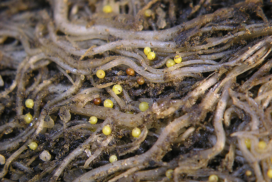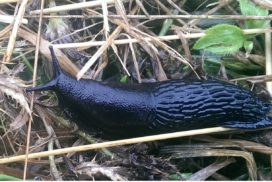Potato Pests
Potato Cyst Nematodes

Potato Cyst Nematodes (PCN) are an important pest of potatoes. There are two species namely Globodera rostochiensis (golden cysts) and Globodera pallida (white cysts).
The cysts present in the soil, hatch in the spring. Hatching can be triggered by exudates from potato roots, but some may also hatch even where there is no potato host in the field. Nematodes feed on the roots and high numbers can lead to plants becoming stunted with pale leaves. The damage usually occurs in patches in the field. Where growing conditions are stressful (i.e. wet soils, or drought conditions), symptoms will show up more readily.
On close inspection of the roots, you will find cysts present on the roots. Crop losses can be high if the plants die-back early. Cysts in the soil will hatch during the spring. The nematodes then feed on potato roots. This can lead to symptoms in the plant. Feeding damage to the roots may also lead to secondary fungi attacking the plants. Females feeding on the roots form cysts which can be seen by eye on affected plants.
The mature cysts can be harvested with the cop and transmitted to other fields on affected seed. Others will remain in the soil ready to hatch in future potato crops. A proportion of the cysts will hatch every year even where no potato crops are grown. Exudates from potato roots will lead to a higher proportion hatching when a potato crop is grown again in the field.
Fields can be tested for the presence of potato cyst nematodes. On the basis of the results, advice can be given on treatments and varieties.
Slugs

Field slugs can cause damage to a wide range of plants, particularly seedlings, which can be killed out, but also leaves, stems, grains and tubers. Slugs are most active in mild wet weather. During dry weather, they are most likely to be found at night, but when weather conditions are ideal they can be found on plants, including the heads of cereals.
Crop health update: Post-metaldehyde slug management
Defra announced a ban on metaldehyde use for outdoor use from spring 2020, as a consequence of long standing concerns over it getting into drinking water. At first sight this announcement looks like yet another loss from the pesticide tool chest, and it comes on top of the loss of chlothianidin as a seed treatment which gave some reduction in slug grazing of cereal seed. This leaves us with just a single option for slug control in the form of ferric phosphate. It is never great to be down to just one tool, but the better news is that trials by SRUC and others comparing ferric phosphate efficacy to that of metaldehyde show that, in the main, ferric phosphate tends to be as effective as metaldehyde. Read more here.
Sign up to the FAS newsletter
Receive updates on news, events and publications from Scotland’s Farm Advisory Service
